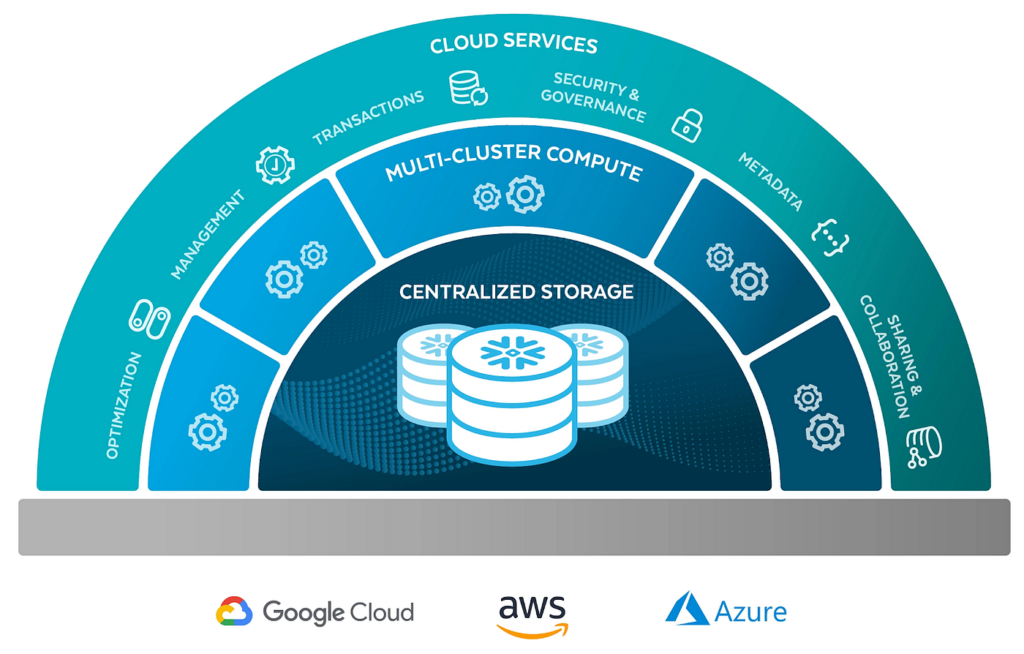Data is one of the most powerful tools available right now. But is your company making the most of its value? Do you know the potential of the most advanced Data Warehouses? Have you ever worked with Snowflake or with a similar solution? Let’s introduce you to the Data Analysis world.
What is Snowflake?
Snowflake is a SaaS-based data warehouse (DWH) platform that runs over an AWS, MS Azure or Google Cloud infrastructure that allows users to store, process, and analyse large volumes of structured and semi-structured data. Some of the features that are important for a data warehouse today are scalability, performance, security, and ease of use.
Snowflake features as a data warehouse (DWH)
Snowflake has some specific features that make it stand out from other data warehouse solutions. Some of them are:
- Cloud-native architecture: As said, Snowflake is built for cloud platforms like AWS, Azure, and Google Cloud, and thus, it can leverage their native services and features.
- Elasticity: Snowflake can automatically scale up or down based on the workload, optimizing resource usage and cost.
- Separation of storage and compute: Snowflake decouples the storage layer from the compute layer, allowing users to independently scale and manage them.
- Multi-cluster shared data architecture: Snowflake enables concurrent access to the same data by multiple compute clusters, without compromising performance or consistency.
- Support for diverse data formats: Snowflake can ingest and query JSON, Parquet, Avro, ORC, XML, and even raw binary data, without requiring any transformation or schema definition.
- Secure data sharing: Snowflake allows users to securely share data across different accounts, organizations, or regions, without copying or moving the data.

Comparing snowflake with other Data Warehouses in the market
In the dynamic landscape of data warehousing, Snowflake stands as a prominent contender alongside other robust platforms like BigQuery, Databricks, and Redshift. Each of these data warehousing solutions brings its unique set of features and advantages, catering to diverse business requirements and preferences.
BigQuery: Google’s Analytics Powerhouse
BigQuery, from Google Cloud, has gained recognition for its serverless architecture, allowing organizations to scale their analytics operations without the complexities of infrastructure management. It’s particularly appealing to businesses entrenched in the Google ecosystem, offering seamless integration with various Google Cloud services.
Comparison
As explained before, Snowflake’s strengths lie in its multi-cloud compatibility, independent scaling, and support for diverse analytic workloads, making it a versatile choice, especially for hybrid environments.
In contrast, BigQuery, designed for Google Cloud, excels in speed and seamless integration within the GCP ecosystem. It’s a rapid choice for tasks like ad-hoc analysis and machine learning workflows, particularly if your organization heavily relies on Google Cloud.
Ultimately, your decision comes down to your cloud strategy and use cases. If you prioritize integration and speed within Google Cloud, BigQuery is a strong contender. However, if you require multi-cloud capabilities, workload versatility, and hybrid environment compatibility, Snowflake may better suit your needs.
DataBricks: Bridging the Data Warehouseing and Data Science Divide
Databricks offers a unified analytics platform that seamlessly blends data warehousing and data science capabilities. This convergence enables organizations to streamline their entire data lifecycle, from data ingestion and transformation to advanced analytics and machine learning.
Comparison
As said, Snowflake is renowned for its cloud-native design, instant scalability, and outstanding price-performance ratio, making it a versatile choice for various analytics workloads. Furthermore, it simplifies cloud data warehousing, particularly for tasks like BI, data analytics, and reporting.
In contrast, Databricks takes a different approach, providing depth and flexibility ideally suited for data engineering, data science, and machine learning use cases. If your needs extend beyond basic analytics and encompass complex data processing and machine learning, Databricks, akin to a comprehensive toolkit, stands as the solution of choice.
RedShift: Amazon’s Data Warehouse
Redshift has long been a stalwart in the data warehousing realm, providing a reliable, scalable, and cost-effective solution. As an integral component of the AWS ecosystem, Redshift offers effortless integration with other AWS services, creating a comprehensive cloud solution.
Comparison
Snowflake shines when it comes to speed, agility, and efficiency. It boasts independent scaling, exceptional concurrency management, and remarkable adaptability.
On the other hand, Redshift offers robust construction, unwavering stability, and substantial capacity, akin to a dependable, multi-purpose tool in the toolbox. But like such a tool, Redshift’s tight integration with AWS and its single-tenancy model may limit its agility and ability to seamlessly span multiple cloud environments.
Conclusion
Snowflake has several advantages over its competitors. Its architecture separates compute power, data storage, and client services, allowing them to operate independently. This design enables faster performance, concurrent tasks, and also supports structured and semi-structured data in its storage architecture. Snowflake’s pricing model is also more flexible than BigQuery and Redshift, as it charges per second of computation time. This can be a competitive option if you’re running small and frequent queries. Snowflake also offers considerable storage options at varying rates, making it a versatile choice for enterprises with diverse storage requirements.
In conclusion, all four competitors have their strengths and weaknesses. BigQuery has excellent scaling potential for its pricing model while Snowflake is more flexible. Databricks and Redshift have an hourly pricing model based on virtual machines used in your cluster while Snowflake charges per second of computation time. Nevertheless, it’s worth noting that Snowflake’s architecture and pricing model render it an exceptionally versatile choice, especially for enterprises with a wide array of storage requirements.





